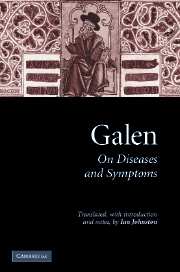Book contents
- Frontmatter
- Contents
- List of tables
- Acknowledgements
- List of abbreviations
- PART I INTRODUCTION
- PART II TRANSLATION
- II.0 Introduction
- II.1 On the Differentiae of Diseases
- II.2 On the Causes of Diseases
- II.3 On the Differentiae of Symptoms
- II.4 On the Causes of Symptoms I
- II.5 On the Causes of Symptoms II
- II.6 On the Causes of Symptoms III
- PART III CONCLUSION
- Bibliography
- Index
II.5 - On the Causes of Symptoms II
Published online by Cambridge University Press: 22 September 2009
- Frontmatter
- Contents
- List of tables
- Acknowledgements
- List of abbreviations
- PART I INTRODUCTION
- PART II TRANSLATION
- II.0 Introduction
- II.1 On the Differentiae of Diseases
- II.2 On the Causes of Diseases
- II.3 On the Differentiae of Symptoms
- II.4 On the Causes of Symptoms I
- II.5 On the Causes of Symptoms II
- II.6 On the Causes of Symptoms III
- PART III CONCLUSION
- Bibliography
- Index
Summary
SYNOPSIS
I.1 A list of abnormal movements, with recognition of a basic division into those that are natural but brought on by disease, and those that are not natural.
I.2 Natural movements are those due to one of the four capacities – as the separative capacity is responsible for sneezing. Movements of the capacities may be perceptible or imperceptible.
II.1 Unnatural movements include paralysis which may involve the various organs.
II.2 Spasm (convulsion) can also affect different structures and is sometimes specifically named (e.g. trismus, strabismus, epilepsy etc.). Such movements may be seen as a conflict between disease and capacity.
II.3 On the mechanism of spasm and its causes.
II.4 On the mechanism of tremor as a succession of alternating movements due to the capacity alternately overcoming and being overcome.
II.5 More on tremor, including the roles of volition, humours, and capacities.
II.6 On palpitation seen as a dilatation due to something flowing into the dilating structure. In view of the time course, this must be ‘airy’ rather than a humour.
II.7 More on palpitation, the movement being seen as a shaking rather than extension/flexion, and as being related to the separative capacity.
III.1 An exhortation to study and become familiar with the functions of the separative or expulsive capacity. Reference is made to the writings of Athenaeus on fever.
III.2 Consideration of the role of the separative capacity in the function of the uterus in childbirth.
III.3 The role of the separative capacity in the stomach causing either vomiting or rapid passage downward.[…]
- Type
- Chapter
- Information
- Galen: On Diseases and Symptoms , pp. 236 - 264Publisher: Cambridge University PressPrint publication year: 2006



